










© 1997-2006
Gareth Knight
All Rights reserved

|
|

Prototypes that became classics!
The process of designing, prototyping, and launching a computer, any computer,
is a long and arduous task. For many bits of hardware in Commodore's archive
the final stage (a finished product) was never achieved. Fortunately there
were many other boards that were refined during months/years of work and
released as a final product. This page presents descriptions and images
of the early versions of the motherboards/expansion cards that would eventually
become the Amigas that we know and love...
Dave Haynie has provided some background information on each of these
items:
|
AMIGA MOTHERBOARDS
|
Blank Amiga 2000 Rev 5 motherboard (lacks components or
other annoyances)
While there are many Amiga 2000s in the world, the Rev 5 is extremely rare.
As far as I know, only about five boards were made. The purpose of the Rev
5 board was simply to add higher density memory to the Amiga 2000. The original
design used sixteen memories for a bank of memory, this design used four
(there are two banks). This was the last Amiga 2000 motherboard I had all
that much to do with.
At the time, the Rev 4.x was in production, and the new board was desired
for new production, as the price crossover from the 256K x 1 to the 256K
x 4 memories had been reached. However, the Rev 5 board was completed
ahead of the need for it. So the PCB guys did some additional cleanup
work on the design, and I think the FCC people got involved, too. Regardless,
the resulting Rev 6 motherboards were plagued with problems (in fairness,
some were due to the switchover to a 68000 with faster signals, that was
also noisier).
|
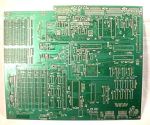 |
 |
A2000 Revision 4
This first motherboard is a Rev 4 German Amiga 2000 motherboard. This is
the one based on the original A1000 logic, not the A500 logic. It supports
only 512K of on-board memory, and the CPU slot is limited in function. This
board appears to be in good physical order, though it hasn't been tested.
There is a note attached:
Works Good!!
Thanks
FYI: Board has
same 1 <-> 31 swap
as early A500's
-Bryce
Apparently a note from Bryce Nesbitt. The "1 <->31 swap" was for pin
numbers on the ROM. Commodore has apparently received bogus information
about which pin would supply the next address line, as these ROMs grew
from 256K to 512K. The German A2000 and some early A500s had this problem,
as the note says. The correct information prevented this issue in US Amiga
2000s.
|
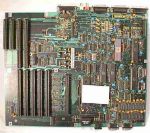 |
B2000 Revision 3.8
The board to the right is a US "B2000" Rev 3.8 (preproduction) Amiga 2000.
This has been stripped of its ROM and its 8520s, but it does include the
Buster "Tower". That tower's my fault, lemme 'splain. When I took over the
Amiga 2000 project, in the fall of 1986 (well, after the shock wore off),
I set out to implement the first "Buster" (Bus controller) chip. This did
with the expansion logic much of what Gary and the Fat Agnus did to the
original Amiga 1000 logic: shrunk it in price and in size. Since I was,
in essence, copying the German design (they _do_ look similar, eh), I took
the PAL equations from the Amiga 2000 on the left as my basis for the Buster
chip.
Whoops. There was a bug in the German PALs. There are a set of buffers
between the A2000's local bus (directly on the 68000) and the Zorro bus.
When a Zorro bus master talks to a Zorro bus target, these buffers are
supposed to point away from Zorro, toward the local bus. During pre-production
testing at the Commodore plant in Taiwan, I discovered that wasn't the
case with the German A2000, or my shiny new Buster chip -- motherboard
buffers fought with anything driving the expansion bus in this case. Whoops.
In Germany, they fixed it with a new PAL. The Buster "tower" fixed it
here, until a corrected Buster chip could be produced.
The board on to the right is another "B2000" Rev 3.8 board. This one
still has those precious 8520s, but it has been stripped of the 68000,
the ROM, and any sort of Buster chip. All A2000 Busters do work in all
motherboards, you don't need a towered Buster for these older boards.
However, the Rev 3.8 board was questionable with CPU cards -- the primary
reasons for Rev 4 were FCC issues and beefing up the whole coprocessor
mechanism with additional buffers.
|
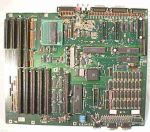 |
 |
|
B2000 Revision 4.3
This final board is a "B2000" Rev 4.3 motherboard, often considered the
first "golden" version of the Amiga 2000. This board has all parts installed,
and there's no obvious reason it shouldn't work, but as with the others,
it hasn't been tested |
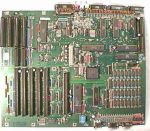 |
Amiga MC68040 module
This is one of the original Commodore/Amiga MC68040 CPU modules for the
Amiga 3000. This one is not widely known, but it predated the A3640 by some
years. Basically, during the Amiga 3000 project, we wanted to get the MC68040
card started quickly, so we hired Scott Schaeffer to build this card. This
is a more complex and expensive design than the A3640, but it also has (in
theory) 128K of L2 cache on-board.
I do say "in theory" because, when I was given this board, they told
me that cache didn't work on it. Far as I know, it hasn't fixed itself
over the years. I do know that it used to work as a normal '040 card,
it may still, but it's sold as-is. When it did work, it ran in an A3000,
where you would substitute the socketed clock buffer (a 74F08 or some-such)
with straight-through wires.
So, back to the fate of this design. It was working at the Amiga 3000
launch, at the Palladium in New York City, April 22, 1990. Motorola flew
in a "special" blessed MC68040 for use to demo, which would have been
the first public demo of a MC68040 product, other than perhaps some Motorola
dog and pony shows. Anyway, at the last minute, Commodore management got
cold feet and yanked the showing.
The card was eventually judged as "too expensive" and cancelled. The
A3640 didn't ship until the Amiga 4000, in September of 1992. Third party
companies had long since supplied '040 cards for the Amiga 3000/3000T.
|
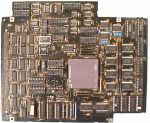 |
A4000 Rejects
A pair of Amiga 4000 motherboards. Not just any Amiga 4000 motherboards,
but a pair of boards soundly rejected by Commodore's product assurance group.
The "toe-tags" are still attached.
This first board is missing RAM, ROM, and the Fat Gary chip (you can
see the missing Gary just blow-right of the SIMM sockets). The failure
is listed as "blank screen". They seem to have replaced U156, U250, U100,
C400A, U400, FB975, U701, U300, and perhaps a few other chips. Basically,
they were clueless about how to get this board up, from what I see here.
The second one is complete, other than for SIMM modules. They replaced
an incorrect U890, fixed some possible solder bridges, replaced U450,
U212, U480, and messed a bit with solder flow on some chips.
|
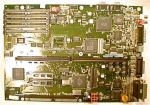 |
 |
|
|
|
AMIGA ADD-ON BOARDS
|
|
|
Amiga 2052
A specially modified A2052, used in the past for Amiga Kickstart development.
The switch on the back set the mode, as I recall, and the pushbutton was
some kind of reset. |
 |
Amiga 2630, Rev. 3 cards
These first two A2630 cards are Revision 3 A2630s, prototypes. The
top one has 2MB of memory, it's missing the FPU and the boot ROM. The second
board is also a Revision 3, with 4MB on-board and all of the normal parts
installed except the expansion edge connector. That's actually ok, though,
for even if this one works, the expansion connector changed in production,
so it would be useless on a Rev 3 PCB. |
 |
Amiga 2630, Rev. 4 cards
The first one is based upon the Revision 4 PCB, also pre-production and
lack the expansion edge found in the final revision.
The second board here is a full fledged Revision 9, full production board,
with production burn-in stickers. It also has 4MB of memory on-board, and
all necessary chips (the empty socket on the far left is for the optional
FPU clock model; the standard configuration runs both at 25MHz). |
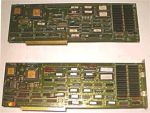 |
A2630 memory expansion card
An add-on memory board for the A2630, from DKB Software (Dean Brown's company).
This board adds up to 32MB (32-bit SIMMS, fast-page mode) of additional
Fast RAM to an A2630 board. |
 |
A2631
Some time after the Amiga 3000 had been shipping, we discovered that Commdore
was still shipping many, many Amiga 2500/30 systems. Why? People liked the
larger box, especially for Video Toaster applications. Given that the A2630
was relatively expensive and limited in memory, this just didn't seem right.
In answer to this, we made the Amiga 2631 that you see here. This was
basically an Amiga 3000 on a card for the Amiga 2000, with 68030, Buster,
RAMSEY, and the DMAC, and support for the full 16MB of fast memory (hey,
that was quite a bit back in 1990). In typical Commodore-of-the-early-90s
fashion, management got insane and didn't let us even finish the prototype,
much less replace the A2630+A2091 with it.
This board is pretty empty: no Buster, RAMSEY, DMAC, or support PALs.
There is a CPU, but no FPU and no memory.
|
 |
Zorro 3 BIGRAM memory card prototypes
The first two are based on the article BigRAM Z3, originally for an Amiga
developer's conference. The two cards are the same (there was only one revision),
without memory. The first has a fully socketed memory array, the second
half socketed. These use the same ZIP memories used in the Amiga 3000; the
board can support either 8MB or 32MB total. These probably work -- the memories
seem to have been swiped during Commodore's downfall, but they haven't been
tested. |
 |
Original Zorro 3 memory card prototypes
The second two are the original Zorro III test boards. Basically just a
big chunk of static RAM. A homage to the original Zorro I test board, which
was also an SRAM board. The first board is unpopulated, the second is fully
populated. Dave Haynie estimates that these have a memory capacity of 512k. |
 |
Amiga 2620 boards, Rev 1
Two pre-production versions of the Amiga 2620 boards:
The top one is a Revision 1 board with all of the parts and 4MB of memory.
The second one is a bit of a confusion. As you can tell, there are many
parts missing, so it obviously does not work. The board claims to be a Revision
3 board, but it's clearly an earlier prototype than the Revision 1 board
above it. You can tell from the fact it's socketed for DIP memory (Amiga
2000 style) rather than ZIP memory (used on all the production CPU cards
and the Amiga 3000) |
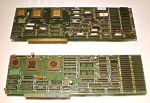 |
Amiga 2620, Rev 3
Two revision 3 versions of the A2620 boards. The top one is missing the
boot ROM and the FPU, it has 4MB of memory, and looks to be a pre-production
unit, or a production unit missing its stickers. The second one is a normal
production unit. |
 |
Zorro 1 Backplane
A backplane for Zorro I expansion cards (also works with Zorro II, though
you plug them in backwards) for the Amiga 1000. These were built by the
Amiga group in Los Gatos, basically as a proof of concept for the Zorro
bus. This backplane is supposed to be powered by a separate power supply
(via the connector at the bottom), but it has been modified to run with
the A1000's own power supply. The card was used by Dave Haynie between 1986
and 1988.
Text and image are taken from Dave Haynie's private collection. |
 |
Commodore A2065 cards - Engineering builds
The two cards are engineering builds of the Commodore A2065 board (Rev 3).
They lack the edge bracket found in the consumer release. The cards are
suitable for A2000, A3000, and A4000 models. |
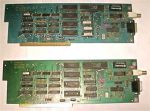 |
Commodore A2065 cards - Production models
As a comparison to the above A2065 cards, here are two production versions
of the above cards - the top board is a Rev. 1 model. The second (bottom)
is a Revision 3 board. |
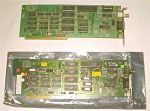 |
BACK
Last Update: 1/11/2001
|
|
|

|
Latest updates to the Amiga History Guide. (more)
|


Other interesting items in the archive!
|
|












